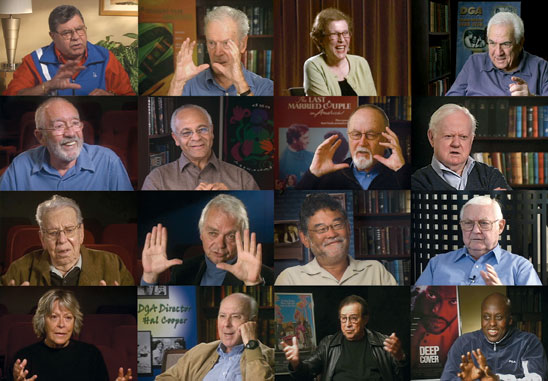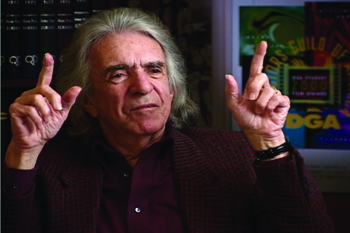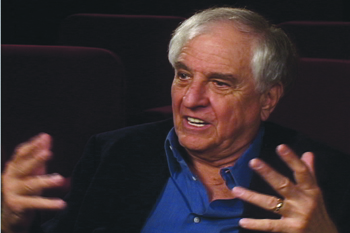BY LIBBY SLATE
 TALKING IT UP: The faces of the DGA's Visual History Program. Top row: Jerry Lewis, Gene Reynolds, Joan Micklin Silver, John Rich; Second row: Marvin Chomsky, Michael Shultz, Gil Cates, Dan Petrie Sr.; Third row: Abby Singer, Jerry Ziesmer, Gary Shimokawa, Robert Wise; Bottom row: Joan Tewkesbury, Hal Cooper, Paul Mazursky, Bill Duke
TALKING IT UP: The faces of the DGA's Visual History Program. Top row: Jerry Lewis, Gene Reynolds, Joan Micklin Silver, John Rich; Second row: Marvin Chomsky, Michael Shultz, Gil Cates, Dan Petrie Sr.; Third row: Abby Singer, Jerry Ziesmer, Gary Shimokawa, Robert Wise; Bottom row: Joan Tewkesbury, Hal Cooper, Paul Mazursky, Bill Duke
In the 1972 psychological thriller Images, the late Robert Altman asked production designer Leon Ericksen to put together the square tiles of a set's parquet floor in the same type of pattern as a crossword puzzle, with black spots and blank spots. "It all related to what the characters and the story were about," Altman told an interviewer more than 30 years later. "Everybody on the crew and all the actors knew about it... It helps with that mystique, that 'Oh, we're all doing something here, we're digging deeper than we're supposed to, than is on the surface.' And from that, a steam rises, some kind of ambience, and the audience does get it. They don't know what they're getting, but they get it. And that, to me, is most important."
Pretty cool stuff, but you won't find the rest of this interview in print or on the air; Altman wasn't sharing his directing philosophy with a member of the press, but with fellow director and actress Lee Grant, part of a videotaped conversation that lasted four hours and captured the film icon's recollections and reflections in a way no regular interview possibly could.
Taped in May 2004, the session is now among the 80-and-counting interviews which comprise the DGA Visual History Program, an endeavor designed to explore the art and craft of the director and the director's team via peer interviews with other directors, assistant directors, unit production managers, associate directors and stage managers.
Lasting three to eight hours, the interviews will eventually be accessible to Guild members, scholars and film students, film historians and journalists, documentary filmmakers and the general public.
Created in 2000 by the Special Projects Committee, the Visual History Program was the next logical step beyond the existing oral history program, which had accumulated 55 audiotaped interviews since the early days of the committee. According to Special Projects Executive Gina Blumenfeld, "the program was established to take advantage of the new small-scale digital video recording technology. On video, you can hear the inflection in someone's voice, look at their face and posture, experience their personality, in ways that you can't get from words on a printed page."
Unlike many oral history programs, the DGA does not emphasize chronology, but instead focuses on relevant craft issues. Special Projects Committee Chairman Jeremy Kagan, in consultation with Martin Scorsese, drafted a template of close to 100 questions on 12 topics which includes: starting out; qualities and traits of a director; story development; collaborators and crew; pre-production; production; post-production; marketing and distribution; the best and worst about directing; and Guild involvement.
The questions are provided in advance to both subject and interviewer, who are free to expand—and expound—upon them as they see fit. Sometimes, answers can surprise even the interviewee. "A lot of people who do this work haven't asked themselves why they do this work - they just do it," observes Kagan, who has conducted 14 interviews so far. "There are techniques and tools, but a lot of the choices you make come from deep, from who you are. We're asking them to think about it, which is a challenge. We'll show a clip and ask, 'Why did you do that?'"
The person doing the interviewing is pivotal to the process. "We cast the interviewers very carefully," Blumenfeld says. "We try to find someone who has something in common with the subject - maybe they're friends, know each other through the Guild, do similar kinds of work. Often, the subjects will have their own ideas of who they want to interview them."
It was only natural, for instance, for Garry Marshall to be interviewed by his son, director Scott Marshall, in a session at the DGA last March. "I thought the questions were good," jokes Marshall, "but the fact that it was father-son made it a little difficult, because I couldn't make up things. We talked about the technical, craft side and about the emotional side; what you go through psychologically in doing a film. You can teach the craft, but sometimes the hardest job is just getting people to come out of the trailer."
Indeed, Marshall revealed that during his interview he learned something about equipment from his film school-trained son. As for Scott, "the experience was great, and I'm glad we have it for the archives," he says. "It's very valuable for future filmmakers to hear firsthand what directors were thinking when making their films." Having one director interview another is a plus, he adds, because "directors will ask [pertinent] questions and have a better understanding of the answers, to be able to expand upon them."
Similarly, for a July 2002 session, DGA National Board Alternate Carl Weathers found interviewing director Bill Duke a "very organic" experience. Both men had similar histories as actors who became directors and each has developed a career shooting episodic television. "It really became a conversation. There was a good ebb and flow to it," he says. "Bill is a fascinating guy, and the way he works is fascinating. What came out during the interview was how engaging he is. It wasn't as close to the vest. It was a real joy for me to have a chance to talk to him about directing."
Duke recalls talking about his favorite directors and about film styles, as well as directing as a discipline, "the things people don't really know about directors," he says. "If you ask the average person what a director does, they think it's 'Action' and 'Cut,' and that's it. We talked about everything in between."
Besides shedding light on the professional life stories of venerable directors such as 95-year-old Ronald Neame or the late Vincent Sherman and Robert Wise, the Visual History Program will also serve as a repository for the history for the Guild itself. For instance, in his May 2002 interview, Gil Cates remarked that becoming a Guild member is great because "once the director joins the Guild, he or she is protected in their creative rights. So that, even if you have some fly-by-night producer who happens to have a million bucks and wants to make a movie with you... that stops the producer from cutting the picture differently than you want it to be cut without giving you the opportunity for your input. In other words, what you're really doing when you join the Directors Guild, from my perspective, is, you're really buying an insurance policy."
In order to make the interviewees words of wisdom easily attainable to viewers, a cataloguing method was devised in 2002. "Each interview has its own unique salient points," notes the Guild's archival consultant Dale Ann Stieber, digital archivist of the Occidental College Library Special Collections. "There had to be a way to break down those three- to eight-hour interviews into key categories."
That role is filled by Special Projects staff and Moving Image Archive Studies graduate students from UCLA, who watch each interview, describe all the sections, apply the time code terms, and check out film and television references. It's a painstaking process which, for a four-hour interview, requires 15-20 hours of postproduction. Each tape is digitized into a hard drive for protection; when finished, files are made for viewing via DVD and streaming video and the original master is then put into storage.
The next step in the Visual History process is to make these privileged conversations accessible for members to view. Initially, excerpts of the interviews will be available on a newly designed section of the members-only side of the DGA website, and by the end of 2007 on the public part of the site. Eventually, it's hoped, that as the technology develops, entire interviews will be made available online.
"These detailed and fascinating interviews give an expanded insight into the directing process," says Kagan. "We are fortunate and grateful that so many of our members have generously given of their time and memories to create a visual-audio legacy that will be cherished by future generations."

Arthur Hiller: When we had our big 50th anniversary, we honored Fellini on the East Coast and Kurosawa on the West Coast. And [being president], I hosted the evening for Kurosawa. In the boardroom about 40 or 50 of us had dinner with Kurosawa... And I was at the table with Kurosawa and Huston and I prepared a toast because I thought that was the right thing to do. But I had a Japanese toast and had it written out phonetically. So I'm doing this toast and I'm having trouble - I wasn't doing it too well, and I was becoming more and more embarrassed. Finally I was asking Kurosawa's translator for help, and she helped. Somehow it still wasn't going well, and Paul Mazursky made some kind of joke, and a couple more jokes are going, and I'm still struggling. And finally Kurosawa was helping me do my toast to him in Japanese. So I'm doing my toast and finally I finish and the jokes keep coming. But at least it let me say, 'All right, how many in this room can say you were directed by Akira Kurosawa?' It just worked out so well.

Garry Marshall: The first thing I ever directed was called Hey, Landlord. It was a TV series that was 99th in the ratings, so no one really cared about it. John Rich had directed the pilot... It was three cameras all shooting at the same time. Desi Arnaz and Lucy had kind of developed that, and I wrote for Lucy for three years, and saw how you did physical comedy, which I loved... It was hard to capture with just one take, so with three cameras you could capture the comedy. I realized that's what I had to do when I directed, and I didn't do it very well, because I didn't get clean shots, but slowly and surely I got the hang of it. I saw that all my great shots [didn't matter] if the actor didn't want to do it or was falling asleep or was over acting. Then I realized, you had to go and talk to the actors. And then I'd get all set and I'd realize the costume was no good, and then I was all set again and I realized the makeup looked a little cockeyed, and then everything was falling apart. So I realized the director has to be responsible for everything... and that was only a half-hour TV show. Imagine a movie with camels and extras.

Robert Altman: The DP is the last guard at the door, and you'll want to turn over as much to him as you can. But I work with all sizes and types and kinds of guys. Usually you get somebody, you have a little love affair, and it probably goes three pictures. And I don't think it's ever gone more than that... But I never talk to the cameramen very much. I won't give a setup the night before. If we're going to be shooting basically in the same space and the DP will come to me and say, 'Can I get a setup for tomorrow, so I can get a jump on you,' And I say, 'No, we'll do it in the morning when I get here.' Because I'm going to have a whole night of churning and I don't know, when I get there in the morning I might say, 'I want to do this differently,' or 'I don't think that's going to work.' So in most cases, I don't even pretend at it. Because many times I've gone and said, 'I want to shoot it here and here and here,' and I get there in the morning and I've had an idea or something's occurred to me, or the sun just comes up, and I say, 'No, I want to flip and shoot from this side.' I just don't do that. I just take each day - very little planning.

Joe Sargent: I began to impress people enough... to catch the eye of one very important man, and his name was Adrian Scott, who is a dear, warm human being. He knew I was looking for a break in film, that I loved the medium. He did a very marvelous thing: He generously put my name on one of his scripts [to direct]. Now, mind you, the things I was directing [for the stage] was everything from Ionesco to O'Casey to Shakespeare - some pretty profound stuff. So what was my first film? Lassie. A half-hour of black and white Lassie, which was way beneath my New York training. But hey, it was a break, and I was thrilled, but, at the same time, I didn't want anyone to know I was directing Lassie. But it was the best thing that could happen to any director because nobody in the industry watched a show in its seventh year that's primarily beamed to kids. So I got to do all my mistakes, all my learning process, in the right place.